Every time I bring this Pancit Palabok to our office team meetings, my colleagues' faces light up like it's fiesta season. It's become my signature potluck dish. My officemates love those silky rice noodles swimming in that rich, golden-orange shrimp sauce that just transforms any regular meeting into an impromptu celebration.
My Lola always said her Pancit Palabok recipe was a labor of love, and I didn't understand until I started making it myself. But trust me, once you nail this recipe, you'll be everyone's favorite person at meetings.
I remember being intimidated the first time I tried making Pancit Palabok at home (those restaurant versions looked so complicated). But after countless testing and tweaking, I've finally perfected my version that rivals even the famous panciterias in Malabon.
I'm sharing all my practical tips and tricks, from getting that sauce silky-smooth to preventing the noodles from clumping, little kusina secrets that took me years to discover but will make your first try a sure success.
What is Pancit Palabok?
Pancit Palabok is a luxurious Filipino noodle dish (pancit) featuring rice noodles topped with a rich orange-hued shrimp gravy (palabok) and an array of delicious toppings. This celebratory dish is often served at Filipino gatherings and special occasions.
Jump to:

Why You'll Love This Recipe
- Restaurant-Quality Results - Learn the secrets to achieving that perfect golden-orange sauce that rivals famous panciterias
- Complete Guide - Detailed instructions in both English and Filipino for authentic results
- Make-Ahead Friendly - Components can be prepared in advance for easy assembly
- Celebration-Worthy - Impressive enough for special occasions yet manageable for home cooks
- Time-Tested Recipe - Perfected through generations of Filipino family cooking
Ingredients
Each ingredient in Pancit Palabok plays a vital role in creating its distinctive flavor profile. The rice noodles provide the perfect canvas, while shrimp heads and shells create an intensely flavorful base for the sauce.
Annatto seeds give the dish its signature golden-orange color without affecting taste. The variety of toppings offers contrasting textures: crispy (chicharon, fried garlic), chewy (shrimp, pork), and soft (tofu, eggs).
Calamansi adds the essential bright, citrusy finish that balances the rich sauce and completes this beloved Filipino dish. Every element works together to create layers of flavor and texture in each bite.
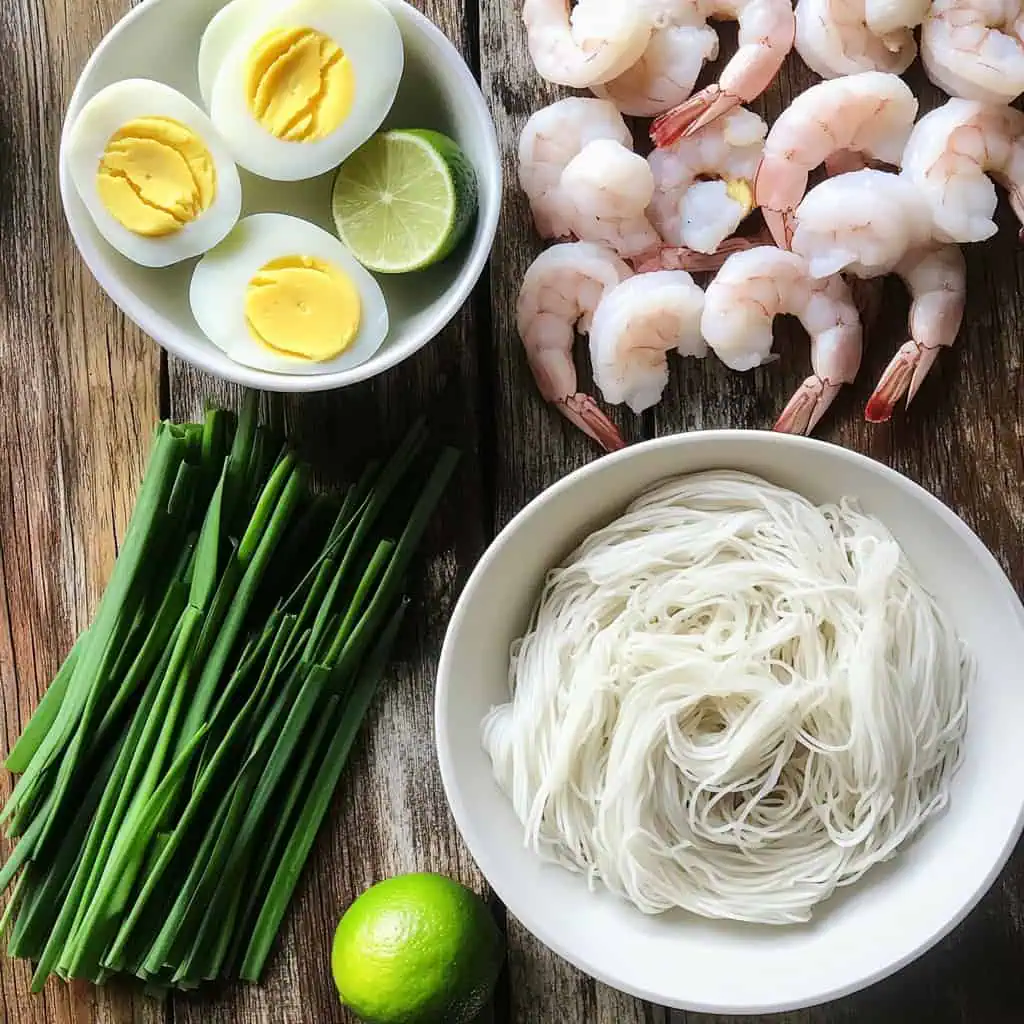
For the Noodles:
- 500 g rice noodles (bihon) or cornstarch noodles
- Water for cooking
- Pinch of salt
For the Shrimp Sauce:
- Shrimp heads and shells from 500g shrimp
- 5 cups water
- ¼ cup cooking oil
- 2 tablespoons annatto seeds (atsuete)
- ⅓ cup all-purpose flour
- 2 shrimp bouillon cubes
- Salt and pepper to taste
For the Toppings:
- 500 g shrimp, peeled and deveined
- 250 g pork belly, diced
- 250 g firm tofu, cubed
- ½ cup smoked fish flakes (tinapa)
- 1 head garlic, minced
- 1 cup crushed pork cracklings (chicharon)
- 4 hard-boiled eggs, quartered
- ¼ cup green onions, chopped
- Calamansi or lemon wedges
Equipment
- Large Pot (6-8 quart) - For cooking the noodles and preparing the shrimp stock
- Fine Mesh Strainer - To strain the shrimp stock, ensuring a smooth sauce
- Heavy-Bottomed Saucepan - For making the sauce, distributes heat evenly to prevent burning
- Wok or Deep Frying Pan - For frying toppings like pork belly and tofu
- Whisk - Essential for preventing lumps when making the sauce
- Kitchen Thermometer - Helps achieve precise cooking temperatures
- Large Serving Platter - Traditional presentation is on a large plate for sharing
- Small Bowls - For organizing toppings during mise en place
- Sharp Knife - For precise cutting of meats and vegetables
- Wooden Spoon - For stirring without scratching cookware
- Measuring Cups and Spoons - For accurate ingredient measurements
- Tongs - Helpful for handling noodles and fried ingredients

How To Make
- First, gather all your ingredients and organize them into three groups: noodles, sauce ingredients, and toppings. This organization, known as mise en place, will make your cooking process smoother.
- Start by peeling and deveining the shrimp. Set the peeled shrimp aside and keep all shells and heads for making the sauce. These will give your sauce a deep, rich flavor.
- Pour 5 cups of water into a large pot and add the shrimp heads and shells. Bring to a gentle simmer at 180°F (82°C). Let this cook for 20 minutes to create a flavorful stock. Strain the liquid and set aside 5 cups of the shrimp stock.
- While the stock simmers, prepare your other ingredients. Cut the pork belly into small, bite-sized pieces. Cube the tofu into 1-inch squares. Mince the garlic finely. Quarter the hard-boiled eggs.
- Heat your cooking oil to 170°F (77°C) in a small pan. Add the annatto seeds and stir until the oil turns a deep orange color. Remove and discard the seeds, keeping the colored oil. This atsuete oil gives palabok its signature golden-orange color.
- In a separate pan, heat oil to 350°F (175°C) and fry the diced pork belly until golden brown and crispy, about 8-10 minutes. Remove the pork and drain on paper towels. Save the rendered fat for added flavor in your sauce.
- Using the same oil at 375°F (190°C), fry the tofu cubes until they turn golden brown, approximately 3-4 minutes. Remove and drain on paper towels. The tofu should be crispy outside but still soft inside.
- Bring a pot of water to a gentle simmer at 180°F (82°C). Cook the peeled shrimp until they turn pink, about 2-3 minutes. Remove immediately to prevent overcooking. Keep the cooking liquid for extra flavor.
- Now prepare the signature palabok sauce. Heat the annatto oil in a large pan to medium heat (350°F/175°C). Add the flour and cook while stirring constantly. This creates a roux that will thicken your sauce.
- Gradually add the shrimp stock to the roux, whisking continuously to prevent lumps. Add the shrimp bouillon cubes, salt, and pepper. Simmer at low heat (180°F/82°C) until the sauce reaches your desired thickness. It should coat the back of a spoon but still be pourable.
- Bring a large pot of water to a full boil (212°F/100°C). Add a pinch of salt. Cook the rice noodles until they are al dente (tender but firm), about 3-4 minutes. Drain immediately and rinse briefly with cold water to stop the cooking process. The noodles should be cooked but still firm to the bite.
- To assemble, place the noodles on a serving platter. Pour the hot sauce generously over the noodles. Top with the cooked shrimp, crispy pork belly, fried tofu, and quartered eggs. Sprinkle with the minced garlic, smoked fish flakes, crushed pork cracklings, and chopped green onions.
- Serve immediately while hot, with calamansi or lemon wedges on the side. Each diner can squeeze calamansi juice over their portion according to taste.

Tips from Lola's Kitchen
For Better Sauce:
- Toast the flour slightly before adding liquid to eliminate the raw flour taste and add depth to your sauce
- Use reserved oils from cooking toppings to incorporate more flavor into your sauce
- Add a dash of fish sauce for extra umami depth
- For a smoother sauce, blend the shrimp heads and shells before straining to extract maximum flavor
- The sauce should be thick enough to coat noodles but still have a pourable consistency
- Make sure to continuously whisk when adding stock to your roux to prevent lumps
For Perfect Noodles:
- Don't oversoak the noodles as they will continue cooking when hot sauce is poured over them
- Keep them slightly firm when cooking as they will soften more as they sit
- Rinse with cold water if not serving immediately to prevent sticking
- Toss with a tiny bit of oil after cooking if you need to hold them for a while
- Fresh noodles require less cooking time than dried ones
Traditional Serving Suggestions:
- Serve on banana leaves for special occasions for authentic presentation and subtle flavor
- Arrange toppings in sections for visual appeal before mixing
- Always serve with calamansi on the side for that essential citrus burst
- Traditionally eaten for birthdays as noodles symbolize long life
- Have everyone mix their own portion at the table for the freshest experience
Substitutions
- No Annatto Seeds? Use paprika or turmeric for color, though the flavor will be slightly different
- No Tinapa? Use crushed dried shrimp (hibe) or even bacon bits for smokiness
- No Calamansi? Use lemon or lime instead for the necessary citrus element
- Vegetarian Version? Use mushroom stock instead of shrimp stock and double the tofu as protein
- No Shrimp? You can use chicken or pork stock with shrimp bouillon for flavor
- Gluten-Free? Replace flour with cornstarch or rice flour for thickening
- No Chicharon? Use crushed toasted nuts or crispy fried shallots for crunch
- Seafood Allergies? Use chicken broth and pork floss as main protein sources
Troubleshooting
Lumpy Sauce?
- Problem: Flour wasn't incorporated properly into the roux
- Solution: Strain sauce through a fine mesh sieve or blend with an immersion blender
- Prevention: Next time, add liquid gradually while whisking continuously
Soggy Noodles?
- Problem: Noodles overcooked or left sitting too long with sauce
- Solution: Cook fresh batch of noodles al dente and serve sauce immediately
- Prevention: Cook noodles just before serving and keep sauce separate until ready to eat
Pale Sauce Color?
- Problem: Not enough annatto oil or color didn't extract fully
- Solution: Add more annatto oil or a pinch of paprika
- Prevention: Heat annatto seeds longer in oil and stir continuously to extract color
Sauce Too Thick?
- Problem: Too much flour or sauce reduced too much
- Solution: Gradually add warm shrimp stock while whisking until desired consistency
- Prevention: Use proper flour-to-liquid ratio and monitor sauce consistency
Sauce Too Thin?
- Problem: Not enough thickening agent or inadequate simmering time
- Solution: Create a slurry with 1 tablespoon flour and 2 tablespoons cold water, whisk into sauce
- Prevention: Allow sauce to simmer longer to reduce and thicken naturally
Storage & Reheating
Storage:
- Refrigerate components separately for best quality
- Sauce: Keeps for 3 days in refrigerator, up to 3 months in freezer
- Noodles: Store dry for up to 2 days in refrigerator
- Toppings: Most toppings keep for 2-3 days in refrigerator, except crushed chicharon which should be added fresh
- Complete dish: Not recommended for storage once assembled
Reheating:
Microwave Method:
- Heat sauce separately until bubbling (about 2 minutes, stirring halfway)
- Warm noodles briefly with a sprinkle of water (30-45 seconds)
- Combine and add fresh toppings
Stovetop Method:
- Dip noodles in hot water for 30 seconds to refresh
- Heat sauce in saucepan with extra stock if needed
- Warm toppings separately in oven (except chicharon and green onions)
- Combine just before serving
For Best Results:
- Store crispy toppings (chicharon, fried garlic) separately and add just before serving
- Add fresh green onions when reheating for brightness
- Keep extra stock on hand to thin sauce when reheating

FAQ
Can I make this ahead of time?
Yes, you can prepare all components separately up to 2 days in advance and store in the refrigerator. Assemble just before serving for best texture and flavor. The sauce actually develops more flavor overnight.
Why is my sauce too thick/thin?
Sauce thickness depends on flour ratio and simmering time. Adjust by adding more stock (if too thick) or simmering longer (if too thin). A perfect palabok sauce should coat the back of a spoon but still flow easily.
How do I prevent noodles from sticking together?
Toss noodles with a small amount of oil after cooking and draining. If making ahead, rinse cooked noodles with cold water, drain well, then toss with a teaspoon of oil before storing.
Is this gluten-free?
Not in its traditional form, but you can easily adapt it by using cornstarch instead of flour for thickening the sauce and ensuring your noodles are rice-based (bihon) rather than wheat-based.
How do I know when the shrimp is perfectly cooked?
Shrimp should turn from translucent to opaque pink and just curl into a loose "C" shape. If they curl into a tight "O" shape, they're overcooked. They typically need only 2-3 minutes in simmering water.
Can I use pre-peeled shrimp?
Yes, but you'll lose the flavor from the shells for your stock. If using pre-peeled shrimp, enhance your stock with shrimp bouillon cubes or bottled clam juice for more seafood flavor.
What is the difference between Pancit Palabok and Pancit Luglug?
They're essentially the same dish with regional naming differences. Some say Luglug uses thicker noodles, but in practice, most people use them interchangeably.
How spicy should Palabok be?
Traditional Palabok isn't meant to be spicy, but many people enjoy adding chili garlic oil or fresh chilies as a topping. Serve hot sauce on the side so guests can adjust to their preference.
Can I freeze leftover Palabok?
Freeze the sauce separately for up to 3 months, but avoid freezing the noodles or assembled dish as the texture will suffer significantly. Toppings like pork and shrimp can be frozen separately.
What drinks pair well with Pancit Palabok?
Calamansi juice is the traditional pairing. Other good options include coconut water, iced tea, or for celebrations, a light beer or white wine.
Related
Looking for other recipes like this? Try these:

Pancit Palabok (Pancit Luglug)
Ingredients
For the Noodles (Pangkaraniwang Sangkap)
- 500 g rice noodles bihon or cornstarch noodles
- Water for cooking
- Pinch of salt
For the Shrimp Sauce (Para sa Sarsa)
- Shrimp heads and shells from 500g shrimp
- 5 cups water
- ¼ cup cooking oil
- 2 tablespoons annatto seeds atsuete
- ⅓ cup all-purpose flour
- 2 shrimp bouillon cubes
- Salt and pepper to taste
For the Toppings (Mga Toppings)
- 500 g shrimp peeled and deveined (hipon)
- 250 g pork belly diced (liempo)
- 250 g firm tofu cubed (tokwa)
- ½ cup smoked fish flakes tinapa
- 1 head garlic minced (bawang)
- 1 cup crushed pork cracklings chicharon
- 4 hard-boiled eggs quartered (itlog)
- ¼ cup green onions chopped (sibuyas na mura)
- Calamansi or lemon wedges kalamansi
Instructions
- First, gather all your ingredients and organize them into three groups: noodles (pancit), sauce ingredients (mga sangkap para sa sarsa), and toppings (mga pangtabon). This organization, known as mise en place (paghahanda ng mga sangkap), will make your cooking process smoother.
- Start by peeling and deveining the shrimp (balatan at tanggalin ang ugat ng hipon). Set the peeled shrimp aside and keep all shells and heads for making the sauce. These will give your sauce a deep, rich flavor (malalim na lasa).
- Pour 5 cups of water into a large pot and add the shrimp heads and shells. Bring to a gentle simmer at 180°F (82°C). Let this cook for 20 minutes to create a flavorful stock (sabaw ng hipon). Strain the liquid and set aside 5 cups of the shrimp stock.
- While the stock simmers, prepare your other ingredients. Cut the pork belly into small, bite-sized pieces (tadtarin ang liempo). Cube the tofu into 1-inch squares (i-kuba ang tokwa). Mince the garlic finely (dikdikin ang bawang). Quarter the hard-boiled eggs (hatiin ang itlog sa apat).
- Heat your cooking oil to 170°F (77°C) in a small pan. Add the annatto seeds (atsuete) and stir until the oil turns a deep orange color. Remove and discard the seeds, keeping the colored oil. This atsuete oil gives palabok its signature golden-orange color.
- In a separate pan, heat oil to 350°F (175°C) and fry the diced pork belly until golden brown and crispy, about 8-10 minutes. Remove the pork and drain on paper towels. Save the rendered fat for added flavor in your sauce.
- Using the same oil at 375°F (190°C), fry the tofu cubes until they turn golden brown, approximately 3-4 minutes. Remove and drain on paper towels. The tofu should be crispy outside but still soft inside (malutong sa labas, malambot sa loob).
- Bring a pot of water to a gentle simmer at 180°F (82°C). Cook the peeled shrimp until they turn pink, about 2-3 minutes. Remove immediately to prevent overcooking (iwasang lutohin ng sobra). Keep the cooking liquid for extra flavor.
- Now prepare the signature palabok sauce. Heat the annatto oil in a large pan to medium heat (350°F/175°C). Add the flour and cook while stirring constantly (ituloy-tuloy ang paghahalo). This creates a roux (binuro) that will thicken your sauce.
- Gradually add the shrimp stock to the roux, whisking continuously to prevent lumps (iwasang magbuo-buo). Add the shrimp bouillon cubes, salt, and pepper. Simmer at low heat (180°F/82°C) until the sauce reaches your desired thickness. It should coat the back of a spoon but still be pourable (dapat kakapal-kapal pero umaagos pa rin).
- Bring a large pot of water to a full boil (212°F/100°C). Add a pinch of salt. Cook the rice noodles until they are al dente (malambot pero may kagat), about 3-4 minutes. Drain immediately and rinse briefly with cold water to stop the cooking process. The noodles should be cooked but still firm to the bite.
- To assemble, place the noodles on a serving platter (bandehado). Pour the hot sauce generously over the noodles. Top with the cooked shrimp, crispy pork belly, fried tofu, and quartered eggs. Sprinkle with the minced garlic, smoked fish flakes (tinapa), crushed pork cracklings (chicharon), and chopped green onions (sibuyas na mura).
- Serve immediately while hot, with calamansi or lemon wedges on the side. Each diner can squeeze calamansi juice over their portion according to taste (tikman at timplahan ayon sa gusto).
- If you need to store components, keep the sauce, noodles, and toppings separately. The sauce can be refrigerated for up to 3 days or frozen for 3 months. The noodles will keep for 2 days in the refrigerator if stored dry. Toppings can be refrigerated for 2-3 days.
- To reheat, warm the sauce over medium heat (160°F/71°C), adding a little water or stock if it's too thick. Heat the noodles separately, then combine with the hot sauce and add the toppings just before serving. This prevents the toppings from becoming soggy (nalalanta) and maintains their distinct textures (tekstura).
- Remember, palabok is best enjoyed fresh and hot, when the noodles are perfectly cooked and the toppings are at their crispiest. The combination of textures - silky noodles, rich sauce, and crunchy toppings - creates the authentic palabok experience that Filipinos have loved for generations.
Tips from Lola's Kitchen
- For Better Sauce
- Toast flour slightly before adding liquid
- Use reserved oils from cooking toppings
- Add a dash of fish sauce for umami
- For Perfect Noodles
- Don't oversoak the noodles
- Keep them slightly firm when cooking
- Rinse with cold water if not serving immediately
Nutrition
The Story Behind Pancit Palabok
In the vibrant tapestry of Filipino cuisine, Pancit Palabok stands as a testament to the Philippines' rich culinary heritage, where Chinese trading influences meet native Filipino ingenuity. This iconic noodle dish, whose name derives from "pancit" (meaning noodles) and "palabok" (meaning sauce or garnish), emerged from the bustling streets of Manila during the Spanish colonial period of the 16th century.
Unlike its Chinese-influenced cousins such as Pancit Canton or Pancit Bihon, Palabok's distinctive orange-hued sauce and elaborate toppings showcase purely Filipino creativity. The dish's signature color comes from achuete (annatto) seeds, a natural food coloring that indigenous Filipinos had been using long before colonial times. This beautiful orange shade isn't just for aesthetics – it's a symbol of prosperity and good fortune in Filipino culture.
The coastal regions of Luzon, particularly Manila Bay, played a crucial role in shaping this dish. The abundance of fresh seafood, especially shrimp, influenced the development of the flavorful sauce that makes Palabok unique. Local cooks would use shrimp heads and shells – parts that might otherwise be discarded – to create a rich, flavorful stock, showcasing the Filipino virtue of resourcefulness and sustainability.
What truly sets Pancit Palabok apart is its role in Filipino celebrations. While many pancit varieties are served at birthdays for long life, Palabok's luxurious toppings and time-consuming preparation made it special occasion fare. Traditional Filipino families would gather to help prepare the numerous toppings, turning the cooking process into a social event itself – a practice that continues in many households today.
In modern Filipino cuisine, Palabok has evolved from its humble street food origins to become a beloved staple at both casual carinderia (local eateries) and upscale restaurants. Each region and family has developed their own version, some adding squid ink for depth, others incorporating local seafood varieties, but all maintaining the core elements that make this dish uniquely Filipino: the smooth rice noodles, savory shrimp sauce, and generous array of toppings that create a delightful play of textures in every bite.
Today, whether served from a humble street cart or presented at a grand family fiesta, Pancit Palabok continues to tell the story of Filipino culinary excellence, where simple ingredients are transformed into something extraordinary through time-honored techniques and a deep understanding of flavor. It's more than just a noodle dish – it's a celebration of Filipino creativity, resourcefulness, and the enduring spirit of family gatherings and celebrations.
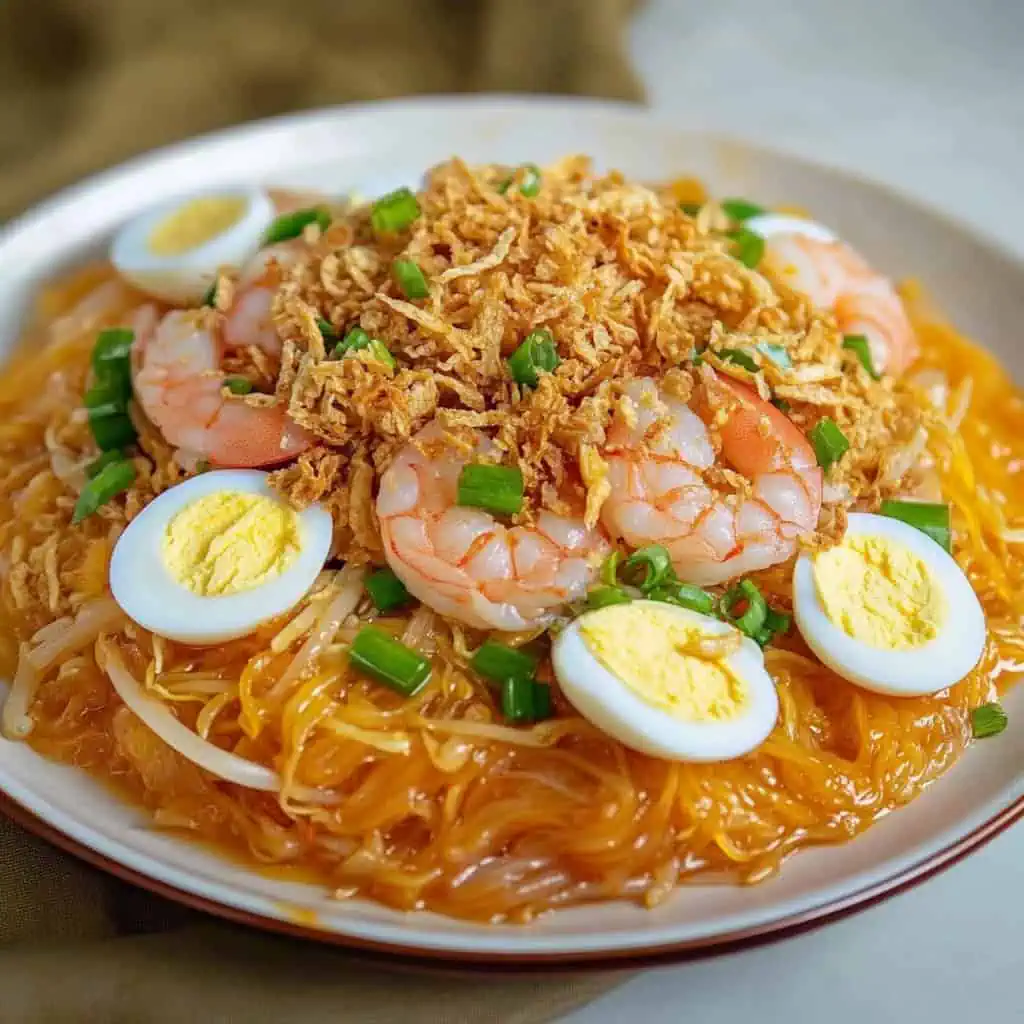





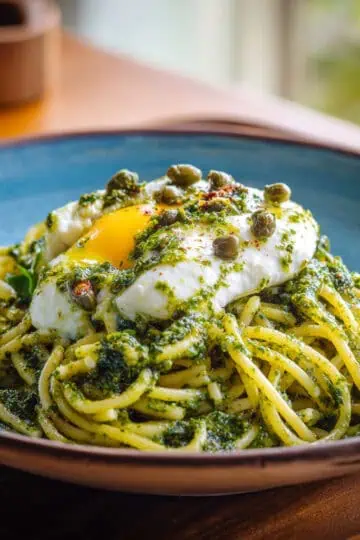
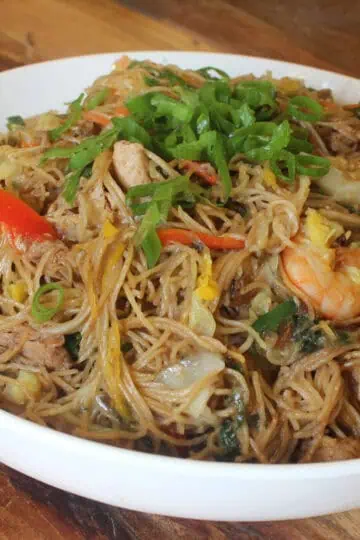
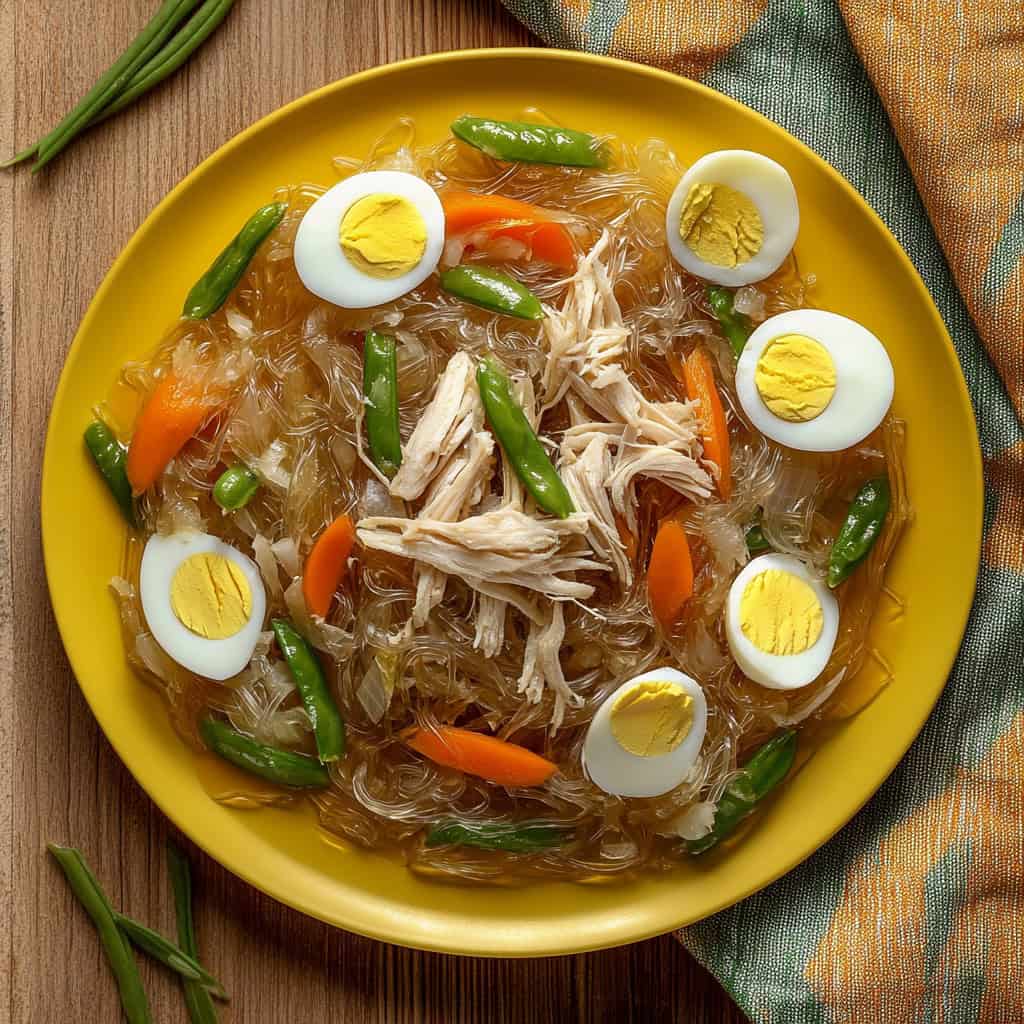
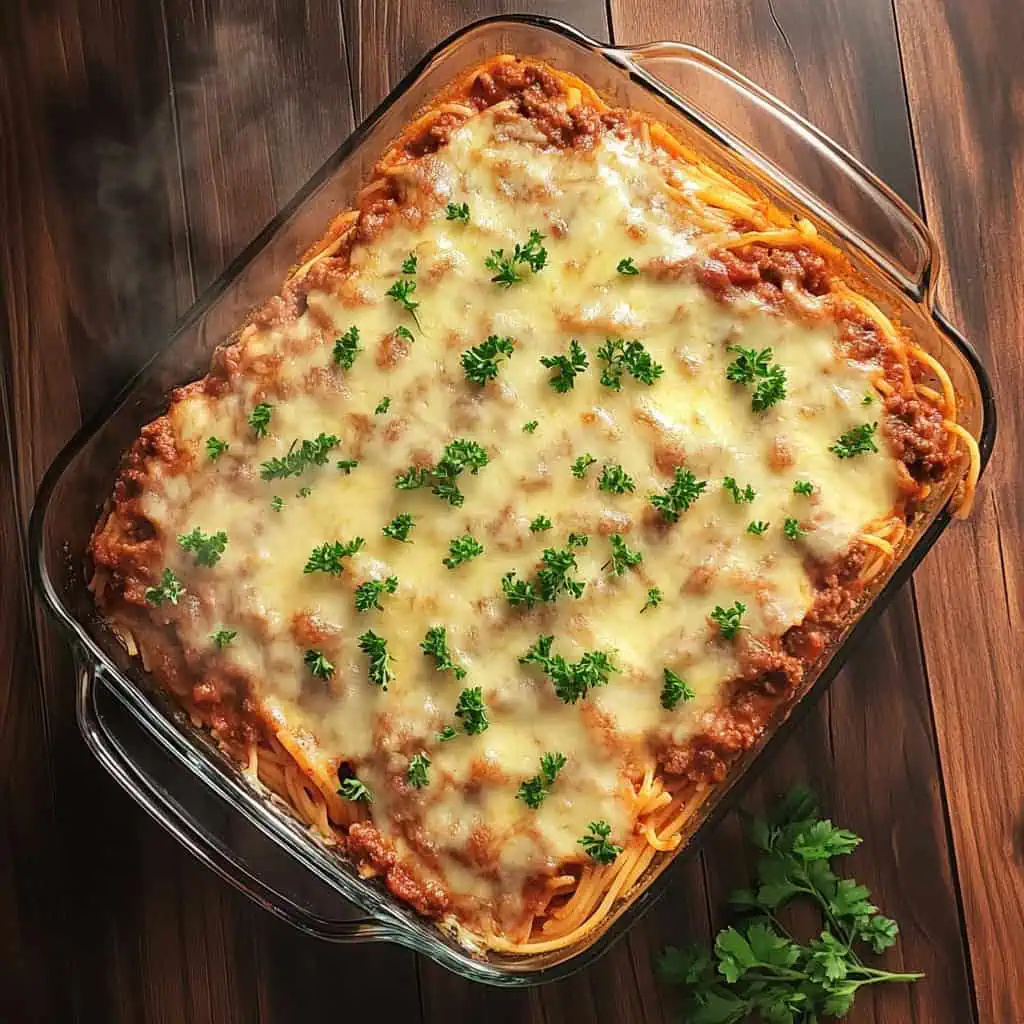
Comments
No Comments